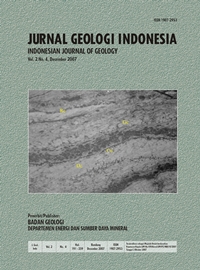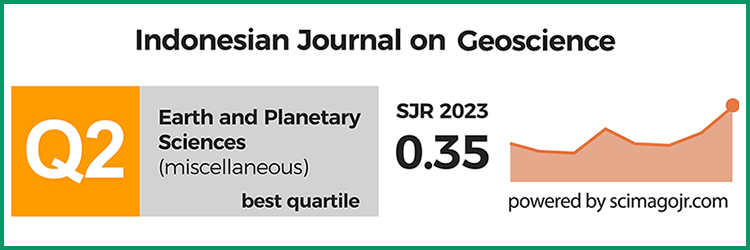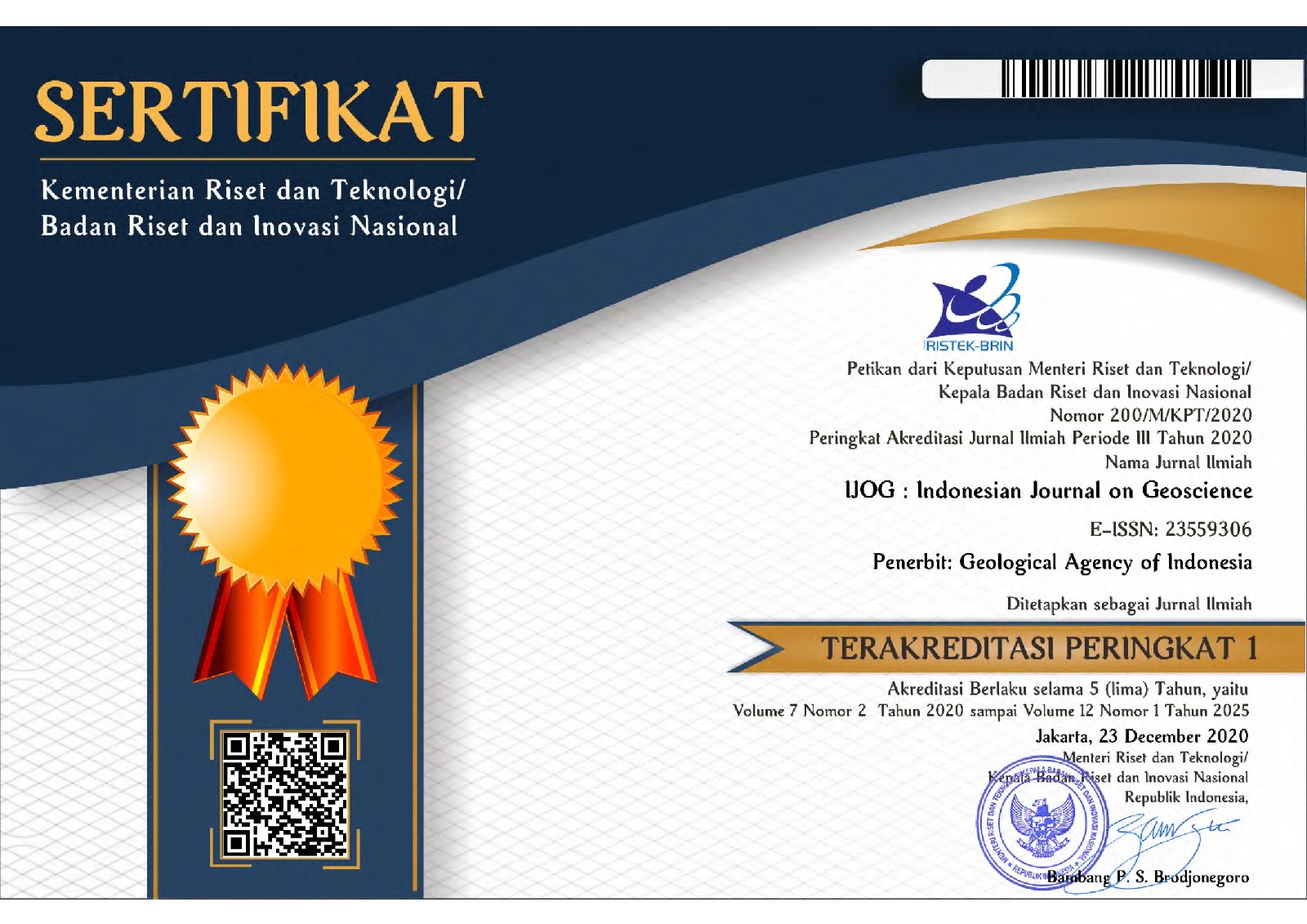Characteristics of volcanic gas correlated to the eruption activity; Case study in the Merapi Volcano, periods of 1990-1994
DOI:
https://doi.org/10.17014/ijog.2.4.235-246Keywords:
volcanic gas, eruption, Merapi Volcano, 1990-1994Abstract
https://dx.doi.org/10.17014/ijog.vol2no4.20074
Volcanic gases, collected from Gendol and Woro solfatara fields, the summit of Merapi Volcano during 1990-1994, show an increase in chemical composition of H , CO, CO , SO , and HCl prior to the volcanic events, on the contrary to the drastic decreasing water vapour. The carbon/sulfur ratio of the volcanic gases lies between 1.5 and 5.7 which means that they were derived from the fresh magma. The Apparent Equilibrium Temperature (AET) which is calculated from chemical compositions of volcanic gases using reaction of SO +3H = H S+2H O showed an increasing value prior to the volcanic events. The Merapi activities lasted during August 1990 to November 1994 showed a significant increase in ratio SO /H S prior to the November 1994 pyroclastic flow.
The isotopic composition of volcanic gas condensates indicates that water vapour in Gendol is directly derived from the fresh magma. On the other hand, the contamination and cooling by the subsurface water occurred around the Woro field at a shallow part.
References
Allard, P., 1983. The origin of hydrogen, carbon, sulfur, nitrogen, and rare gases in volcanic exhalations: evidence from isotope geochemistry. Forecast. Volcan. Event., 25, p.337-397.
Giggenbach, W.F., 1975. A Simple method for the collection and analysis of volcanic gas samples. Bull. Volcanol., 39, p.15-27.
Giggenbach, W.F., 1992. Isotopic shifts in waters from geothermal and volcanic systems along convergent plate boundaries and their origin. Earth Planet. Sci. Lett., 113, p.495-510.
Giggenbach, W.F. and Matsuo, S., 1991. Evaluation of results from second and third IAVCEI Field Workshop on volcanic gases, Mt. Usu, Japan and white Island, New Zealand. Appl. Geochem., 6, p.125-141.
Hirabayashi, J., Yoshida, M., and Ossaka, J., 1990. Chemistry of volcanic gases from the the 62-1 Mt. Tokuchi, Hokkaido, Japan. Bull. Volcanol. Soc. Japan, 2, p. 205-215.
Hirabayashi, J., Ossaka, J., and Ozawa, T., 1982. Relationship between volcanic and chemical composition of volcanic gases - A case study on the Sakurajima Volcano. Geochem. J., 16, p.10-21.
Hirabayashi, J., Ohba, T., Nogami, K., and Yoshida, M. 1995. Discharge rate of SO from Unzen volcano, Kyusu, Japan. Geophys. Res. Lett., 22, p.1709-1712.
Iwasaki, I., Ozawa, T., Yoshida, M., Katsura, T., Iwasaki, B., Kamada, M., and Hirayama, M., 1962. Volcanic gases in Japan. Bull. Tokyo Inst. Technol., 47, p.1-54.
Kazahaya, K., Takahashi, M., and Ueda, A., 1993. Discharge model of fumarolic gases dtrrirtg post-eruptive degassing of Izu-Oshima volcano, Japan. Geochem. J., 27, p. 261-270.
Matsuo, S., 1960. On the origin of volcanic gases. J. Earth Sci. Nagoya Univ., 8, p.222-245.
Matsuo, S., 1961. On the chemical nature of fumarolic gases of Volcano Showashinzan, Hokkaido, Japan. J. Earth Sci. Nagoya Univ., 9, p.80-100.
Menyailov, I.A., Nikitina, L.P., and Shapar, V.N., 1985. Results of Geochemical monitoring of the activity of Ebeko volcano (Kurile Island) used for eruption prediction. J. Geodynamics, 3, p.259-274.
Mizota, C. and Kusakabe, M., 1994. Spatial distribution of δD-δ18O values of surface and shallow groundwaters from Japan, South Korea, and East China. Geochem. J., 28, p.387-410.
Mizutani, Y., 1962. Origin of lower temperature fumarolic gas of Showashinzan. J. Earth. Sci. Nagoya Univ., 10, p. 135-148.
Mizutani, Y. and Sugiura, T., 1982. Variations in chemical and isotopic compositions of fumarulic gases from Showashinzan volcano, Hokkaido, Japan. Geochem. J., 16, p. 63-71.
Ohba, T., Hirabayashi, J., and Yoshida, M., 1994. Equilibrium temperature and redox state of volcanic gas at Unzen volcano, Japan. J. Volcanol. Geotherm. Res., 60, p. 263-272.
Shinohara, H., Giggenbach, W.F., Kazahaya, K., and Hedenquist, J.W., 1993. Geochemistry of volcanic gases and hot springs of Satsuma-Iwojima, Japan: Following Matsuo. Geochem. J., 27, p. 271-285.
Stoiber, R.E. and Rose, W.I., 1970. The Geochemistry of Central America Volcanic Gas Condensaste. Geol. Soc. Am. Bull., 81, p.2891-2912.



















